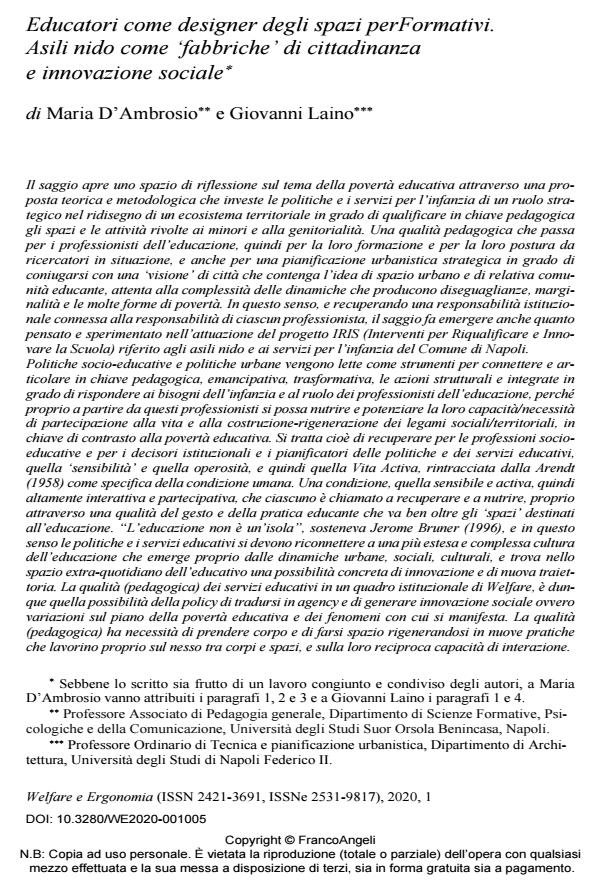Educators as designers of training spaces. Nurseries as ‘factories’ of citizenship and social innovation
Journal title WELFARE E ERGONOMIA
Author/s Maria D’Ambrosio, Giovanni Laino
Publishing Year 2020 Issue 2020/1
Language Italian Pages 19 P. 39-57 File size 371 KB
DOI 10.3280/WE2020-001005
DOI is like a bar code for intellectual property: to have more infomation
click here
Below, you can see the article first page
If you want to buy this article in PDF format, you can do it, following the instructions to buy download credits

FrancoAngeli is member of Publishers International Linking Association, Inc (PILA), a not-for-profit association which run the CrossRef service enabling links to and from online scholarly content.
The essay opens a space to reflecte on the theme of educational poverty through a theoretical and methodological proposal that invests policies and services for children in a strategic role in order to re-design a territorial ecosystem and to qualify in a pedagogically way so-cial/educational spaces and activities aimed at minors and parenthood. A pedagogical quality that needs of education professionals, therefore of their training and their ‘posture’ as re-searchers in situation, and also of a strategic urban planning able to combine a ‘vision’ of cities that contains the idea of urban space with its educational community, attentive to the complexity of the dynamics that produces inequalities, margins and so different forms of pov-erty. In this sense, and recovering an institutional responsibility connected to responsibility of each professional, the essay also highlights what was thought and experimented in the im-plementation of the IRIS project (Interventions to Requalify and Innovate the School) related to nursery schools and services for the childhood of the Municipality of Naples. Socio-educational and urban policies are read as tools to connect and articulate in a pedagogical, emancipatory, transformative key, structural and integrated actions that can answer to people’s needs, nurturing and enhancing their ability/need to participate in life and the construc-tion-regeneration of social/territorial ties. In other words, it is a matter of recovering for the socio-educational professions and for the institutional decision-makers and planners of educational policies and services, to develope sensitiveness and industriousness, that Vita Activa traced by Arendt (1958), as a specification of the human condition. An active and therefore highly interactive and participatory condition that everyone is called upon to recover and nourish, precisely through a quality of the gesture and of the educating practice that goes far beyond the ‘spaces’ intended for education. "Education is not an island", argued Jerome Bruner (1996), and in this sense educational policies and services must be connected to a more extensive and complex culture of education that emerges precisely from urban, social and cultural dynamics, and finds in the extra-daily educational space a real possibility of social innovation. The (pedagogical) quality of educational services in the institutional frame-work of Welfare is therefore that possibility of the policy to develope agency and generating social innovation capable to fight educational poverty and the phenomena with which it oc-curs. Pedagogical quality needs to take shape and make space by regenerating itself in new practices that work precisely on the link between bodies and spaces, and on their mutual in-teraction capabilities. The writing is therefore crossed by an evident epigenetic gaze that holds epistemological re-flection and its methodological request together, and qualifies educational practices as "gyms" of citizenship and social cohesion in a transformative and regenerative key, both in-dividually and politically of policies, so as to bring out the ‘embodied’ methodology (Pfeifer and Bongard, 2007) as a bio-political approach to the ‘sensitive’ government of the ‘living’: because education and politics can together redesign a new ecosystem for the generative pro-cess of the living creature (Dewey, 1934).
Keywords: Shaping space; social innovation; embodied practices.
Maria D’Ambrosio, Giovanni Laino, Educatori come designer degli spazi perFormativi. Asili nido come ‘fabbriche’ di cittadinanza e innovazione sociale in "WELFARE E ERGONOMIA" 1/2020, pp 39-57, DOI: 10.3280/WE2020-001005